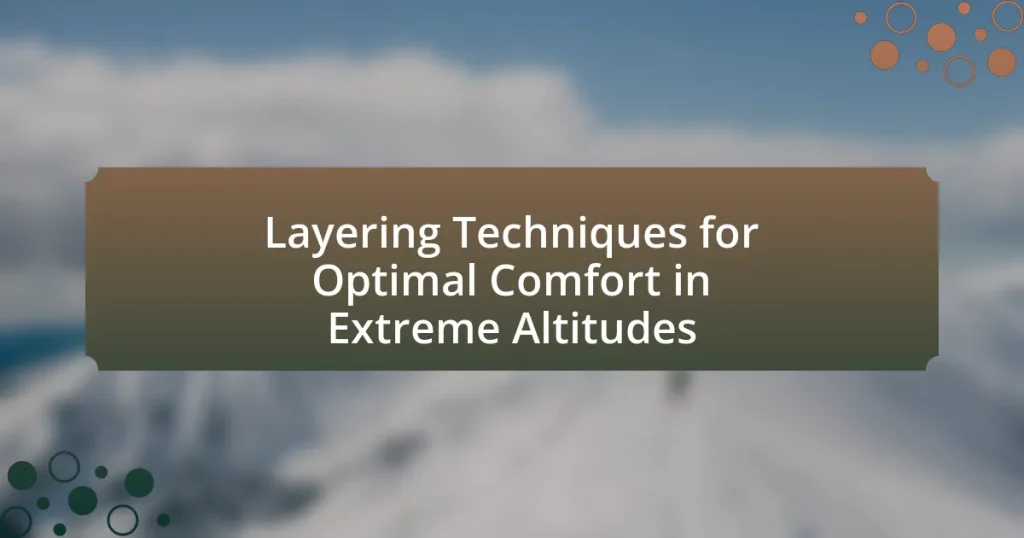Layering techniques for optimal comfort in extreme altitudes involve a structured three-layer system: a base layer for moisture management, an insulating layer for warmth, and an outer layer for protection against environmental elements. The article outlines how each layer functions, emphasizing the importance of moisture-wicking materials, effective insulation, and weather-resistant outer layers in maintaining thermal regulation and comfort. Key principles of layering, common mistakes to avoid, and practical tips for enhancing effectiveness in various weather conditions and activities are also discussed, providing a comprehensive guide for individuals engaging in high-altitude activities.

What are Layering Techniques for Optimal Comfort in Extreme Altitudes?
Layering techniques for optimal comfort in extreme altitudes involve a three-layer system: a base layer for moisture management, an insulating layer for warmth, and an outer layer for protection against wind and moisture. The base layer, typically made of synthetic or merino wool materials, wicks sweat away from the skin, keeping the body dry. The insulating layer, often composed of fleece or down, traps body heat to maintain warmth. Finally, the outer layer, usually a waterproof and breathable shell, shields against harsh weather conditions. This structured approach is supported by research indicating that proper layering can significantly enhance thermal regulation and comfort in extreme environments, as outlined in studies on mountaineering gear effectiveness.
How do layering techniques enhance comfort in extreme altitudes?
Layering techniques enhance comfort in extreme altitudes by providing insulation, moisture management, and adaptability to changing weather conditions. The base layer wicks moisture away from the skin, keeping the body dry and reducing the risk of hypothermia. The middle layer traps heat, providing insulation, while the outer layer protects against wind and precipitation. This system allows for easy adjustment of clothing to maintain optimal body temperature and comfort, which is crucial in extreme environments where temperatures can fluctuate rapidly. Studies have shown that effective layering can significantly improve thermal regulation and overall comfort during high-altitude activities.
What are the key principles behind effective layering?
The key principles behind effective layering include moisture management, insulation, and protection from environmental elements. Moisture management involves using base layers that wick sweat away from the skin to maintain dryness and comfort. Insulation layers trap body heat, utilizing materials like fleece or down to retain warmth. Finally, outer layers provide protection against wind, rain, and snow, ensuring that the individual remains shielded from harsh weather conditions. These principles are essential for maintaining optimal comfort and performance in extreme altitudes, where temperature fluctuations and moisture can significantly impact safety and endurance.
How does insulation play a role in layering techniques?
Insulation is crucial in layering techniques as it retains body heat and prevents heat loss in extreme altitudes. Effective insulation materials, such as down or synthetic fibers, trap air and create a barrier against cold temperatures, enhancing thermal efficiency. Research indicates that proper insulation can reduce heat loss by up to 30%, significantly improving comfort and performance in harsh environments. Thus, incorporating adequate insulation within layering systems is essential for maintaining optimal body temperature and ensuring comfort during outdoor activities at high altitudes.
What are the different types of layers used in extreme altitude conditions?
The different types of layers used in extreme altitude conditions are base layers, insulation layers, and outer layers. Base layers, typically made from moisture-wicking materials, are designed to keep the skin dry and regulate body temperature. Insulation layers, such as fleece or down, trap heat to maintain warmth in cold environments. Outer layers, often waterproof and windproof, protect against harsh weather conditions like wind, rain, and snow. This layering system is essential for maintaining comfort and safety in extreme altitudes, as it allows for temperature regulation and protection from the elements.
What is the purpose of base layers in layering techniques?
The purpose of base layers in layering techniques is to provide moisture management and thermal insulation. Base layers are designed to wick sweat away from the skin, keeping the wearer dry and comfortable in extreme altitudes. This moisture management is crucial because it helps regulate body temperature, preventing overheating during physical activity and reducing the risk of hypothermia in cold environments. Studies have shown that effective moisture-wicking fabrics can enhance thermal regulation, making base layers essential for maintaining optimal comfort in challenging conditions.
How do mid-layers contribute to thermal regulation?
Mid-layers contribute to thermal regulation by providing insulation that traps body heat while allowing moisture to escape. This insulation is crucial in extreme altitudes where temperature fluctuations can be significant. Materials commonly used in mid-layers, such as fleece or down, have high thermal resistance, which helps maintain a stable body temperature. Additionally, the breathability of these materials prevents overheating by facilitating moisture management, ensuring that the wearer remains dry and comfortable.
What role do outer layers play in protection against the elements?
Outer layers serve as the first line of defense against environmental elements such as wind, rain, and snow. These layers are typically made from waterproof or water-resistant materials that prevent moisture from penetrating while allowing moisture vapor from the body to escape, thus maintaining comfort and reducing the risk of hypothermia. For instance, materials like Gore-Tex are designed to be both breathable and waterproof, effectively shielding the wearer from harsh weather conditions while facilitating moisture management. This dual functionality is crucial for maintaining thermal regulation and overall comfort in extreme altitudes, where exposure to the elements can lead to serious health risks.
Why is moisture management important in layering techniques?
Moisture management is crucial in layering techniques because it helps regulate body temperature and maintain comfort in extreme altitudes. Effective moisture management prevents sweat accumulation, which can lead to chilling when temperatures drop, thereby enhancing thermal insulation. Research indicates that materials designed for moisture-wicking can significantly improve comfort levels by keeping the skin dry, thus reducing the risk of hypothermia and improving overall performance in cold environments.
How do different fabrics affect moisture wicking?
Different fabrics significantly affect moisture wicking due to their inherent properties and structure. Synthetic fabrics like polyester and nylon are designed to pull moisture away from the skin and allow it to evaporate quickly, making them ideal for high-performance activities in extreme altitudes. In contrast, natural fibers such as cotton tend to absorb moisture rather than wick it away, leading to a damp feeling and reduced comfort in cold conditions. Research indicates that polyester can absorb up to 0.4% of its weight in moisture, while cotton can absorb up to 25%, demonstrating the superior moisture-wicking capability of synthetic materials.
What strategies can be employed to manage sweat in extreme altitudes?
To manage sweat in extreme altitudes, employing moisture-wicking fabrics and layering techniques is essential. Moisture-wicking materials, such as polyester or merino wool, draw sweat away from the skin, allowing for quicker evaporation and reducing the feeling of dampness. Additionally, using a base layer that fits snugly against the skin can enhance moisture management by facilitating airflow and evaporation. Research indicates that proper layering can significantly improve thermal regulation and comfort, as demonstrated in studies on outdoor performance gear, which show that effective moisture management can enhance endurance and reduce the risk of hypothermia in cold, high-altitude environments.
How can layering techniques be adapted for various activities at high altitudes?
Layering techniques can be adapted for various activities at high altitudes by customizing the number and type of layers based on the specific demands of each activity. For example, during high-intensity activities like skiing or climbing, a base layer made of moisture-wicking fabric is essential to manage sweat, while an insulating mid-layer is crucial for warmth. In contrast, for lower-intensity activities such as hiking, fewer layers may be needed, focusing on breathability and ease of movement.
Additionally, the outer layer should be windproof and waterproof to protect against harsh weather conditions typical at high altitudes. Research indicates that proper layering can significantly enhance thermal regulation and comfort, as evidenced by studies showing that climbers who utilize effective layering strategies experience fewer cold-related injuries and improved performance.
What considerations should be made for climbing versus skiing?
Climbing and skiing require different considerations regarding layering techniques for optimal comfort in extreme altitudes. For climbing, the focus should be on moisture-wicking base layers, insulating mid-layers, and durable outer layers that provide wind and water resistance, as climbers often face variable weather conditions and physical exertion. In contrast, skiing demands layers that prioritize insulation and breathability, as skiers experience high-speed descents and need to manage heat retention while preventing moisture buildup.
Research indicates that climbers benefit from a three-layer system to adapt to changing conditions, while skiers often utilize a two-layer system that emphasizes thermal regulation and flexibility. The American Alpine Institute recommends specific materials like merino wool for base layers in climbing, while skiing gear often incorporates synthetic materials for enhanced moisture management.
How do layering needs change with varying weather conditions?
Layering needs change significantly with varying weather conditions, as different temperatures and moisture levels require adjustments in insulation and breathability. In cold weather, additional insulating layers are necessary to retain body heat, while in warm conditions, lighter, moisture-wicking layers are preferred to facilitate evaporation and cooling. For example, during a snowstorm, a base layer, an insulating mid-layer, and a waterproof outer layer are essential, whereas in dry, hot weather, a single lightweight layer may suffice to prevent overheating. This adaptability is crucial for maintaining comfort and safety in extreme altitudes, where temperature fluctuations can be drastic.
What are common mistakes to avoid when using layering techniques?
Common mistakes to avoid when using layering techniques include failing to choose appropriate materials, neglecting moisture management, and not considering temperature fluctuations. Selecting materials that do not wick moisture can lead to discomfort and hypothermia, as wet fabrics lose insulating properties. Additionally, layering without accounting for changing weather conditions can result in overheating or excessive cold exposure. Lastly, ignoring the fit of each layer can restrict movement and reduce overall effectiveness, as tight layers can impede circulation and loose layers can trap cold air.
How can improper layering lead to discomfort or hypothermia?
Improper layering can lead to discomfort or hypothermia by failing to regulate body temperature effectively. When clothing layers are not appropriately chosen or arranged, moisture can become trapped against the skin, leading to a rapid loss of body heat. For instance, if a base layer is not moisture-wicking, sweat accumulates, cooling the body and increasing the risk of hypothermia in cold environments. Additionally, inadequate insulation layers can fail to retain heat, while overly tight or loose outer layers can restrict airflow or trap excess heat, respectively. Research indicates that maintaining a balance of insulation, moisture management, and ventilation is crucial for thermal regulation in extreme altitudes, where temperatures can drop significantly.
What are the signs that your layering system is not working effectively?
Signs that your layering system is not working effectively include feeling excessively cold or hot, experiencing moisture buildup on your skin, and noticing restricted movement. When the layering system fails, inadequate insulation leads to cold discomfort, while poor breathability causes overheating. Additionally, if sweat accumulates, it indicates that moisture-wicking properties are compromised, which can lead to chilling in cold environments. These signs are critical indicators that adjustments are necessary for optimal performance in extreme altitudes.
What practical tips can enhance the effectiveness of layering techniques in extreme altitudes?
To enhance the effectiveness of layering techniques in extreme altitudes, prioritize using moisture-wicking base layers, insulating mid-layers, and waterproof outer layers. Moisture-wicking materials, such as merino wool or synthetic fabrics, help manage sweat and keep the skin dry, which is crucial in cold environments where moisture can lead to hypothermia. Insulating mid-layers, like fleece or down, trap body heat while allowing for breathability, ensuring warmth without overheating. Finally, waterproof and windproof outer layers protect against harsh weather conditions, preventing wind chill and moisture penetration. According to the American Alpine Institute, proper layering can significantly improve thermal regulation and comfort, making it essential for survival in extreme altitudes.
